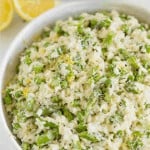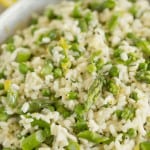This post may contain affiliate links. Please read our disclosure policy.
Are you looking to switch up your spring dinner routine? Lucky you – I have this delicious spring risotto recipe! Made with asparagus, peas, lemon, creme fraiche, and parmesan cheese, this spring risotto is the perfect way to celebrate spring vegetables in season. Not only is it easy and quick to make, but it’s also sure to be a hit with family and friends alike. So if you’re looking for an impressive yet simple dish that everyone will love. get ready to try the best risotto recipe!
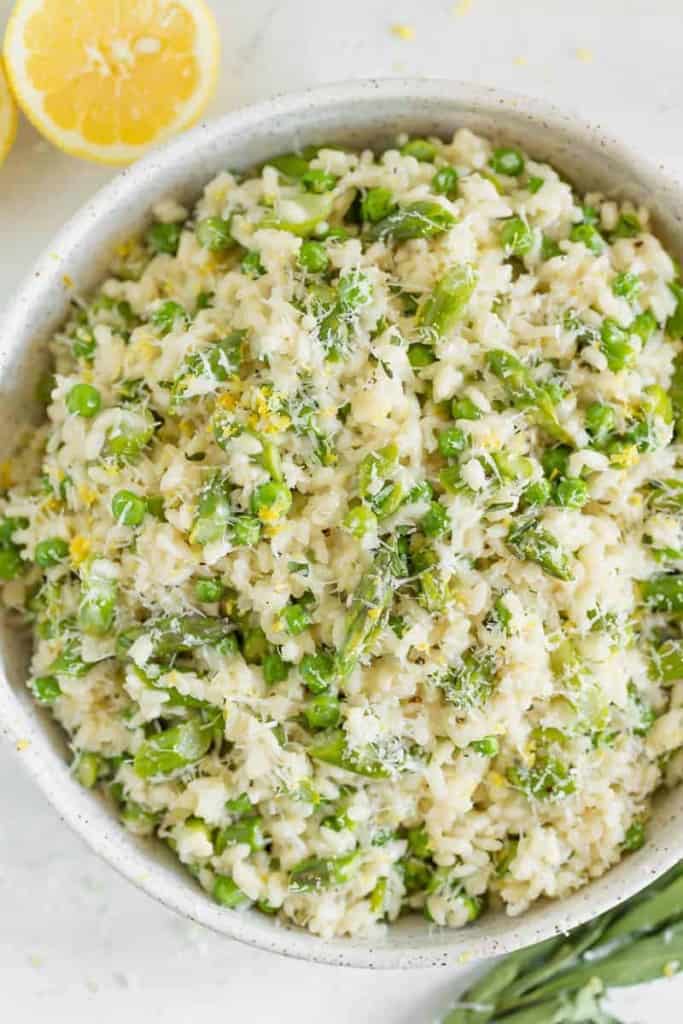
What is risotto?
If you’ve never had get chance to try homemade risotto, you’re in for a real treat! A traditional Italian dish, risotto is creamy and flavorful, making it the perfect spring dinner. It’s made from arborio rice, cooked in a broth to a creamy consistency.
Risotto is traditionally served as a first course or side dish but can also be converted into a main meal. It’s best enjoyed in spring when the vegetables are at their prime and bursting with flavor!
Why this spring risotto is the best
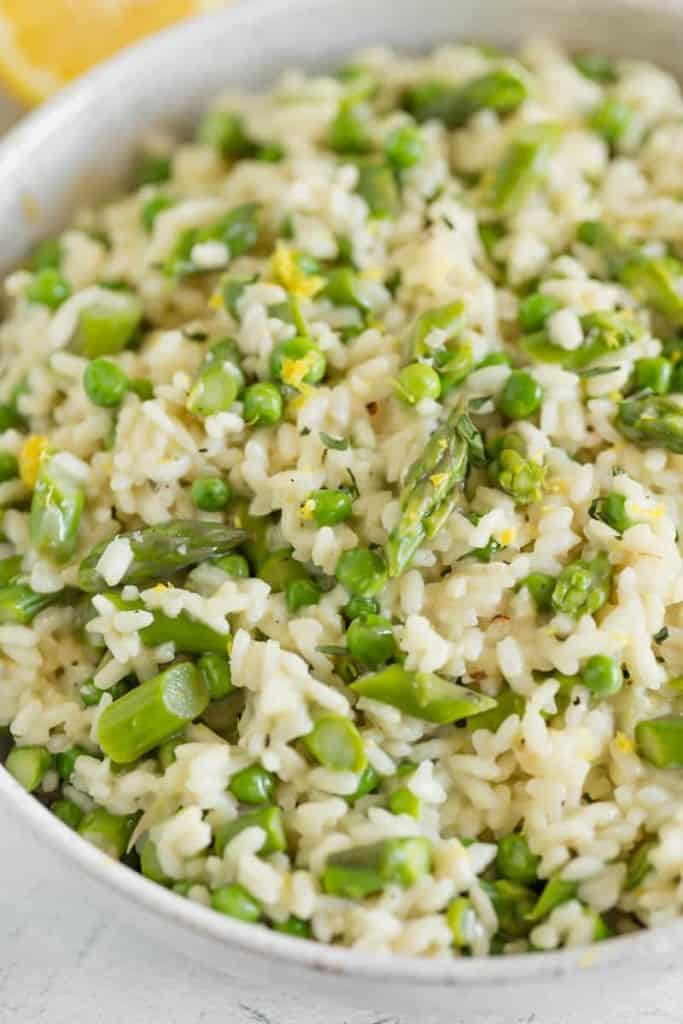
Email this Recipe!
Email this recipe to yourself to save for later.
By submitting this form, you agree to receive emails from Girl with the Iron Cast.
This asparagus risotto recipe is full of spring flavors, featuring the freshest spring veggies like asparagus and peas. Asparagus is in season from February to June, with April being its peak time. Peas are also at their peak in April, although you can enjoy them year-round frozen.
The risotto is also finished with crème fraîche and lemon to give it a rich flavor. Parmesan adds an extra layer of flavor to make it truly special.
Ready to learn how to make this spring risotto? Let’s get started!
Ingredients needed
Here’s everything you need to make this fresh spring dinner recipe:
- Asparagus (ends trimmed and cut into ¼ inch diagonals)
- Peas
- Unsalted butter
- Shallot
- Garlic cloves
- Fresh tarragon
- Arborio rice
- Dry white wine
- Chicken (or vegetable) broth
- Crème fraîche
- Parmesan cheese
- Lemon zest
- Salt and pepper
How to prep the asparagus
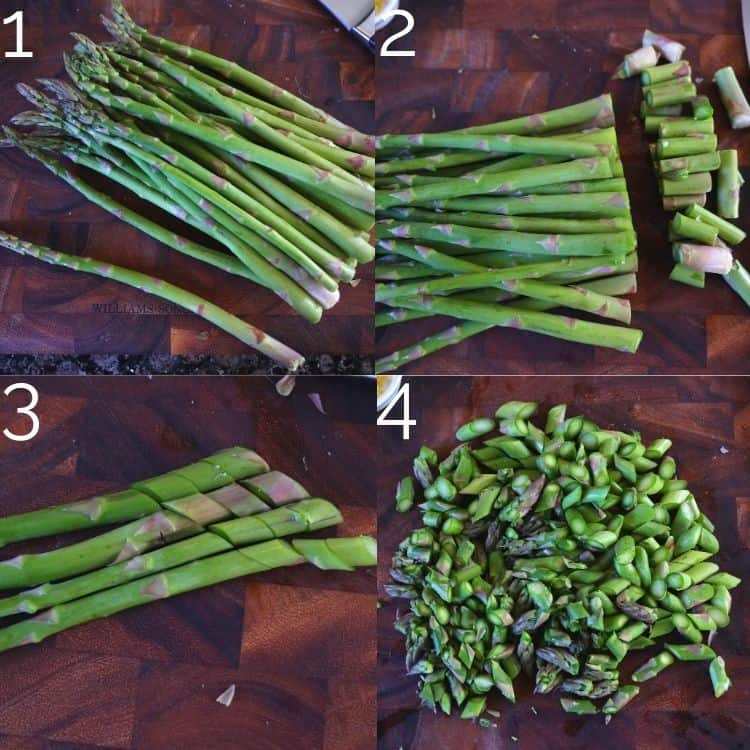
Whenever using fresh asparagus, it’s important to clean the veggie before using it in the recipe.
Here’s everything you need to do to prep the asparagus:
- To make your spring risotto the best it can be, carefully snap off the tough ends of the asparagus with your hands. (The asparagus will snap at the natural point where the toughness begins.)
- Then cut them at a diagonal angle into 1/4 inch pieces – not too big and not too small so that each spoonful will be filled with delightful flavor!
Tip:
When picking asparagus, you want to select firm and straight stalks with the tips closed and compact.
How to blanch vegetables
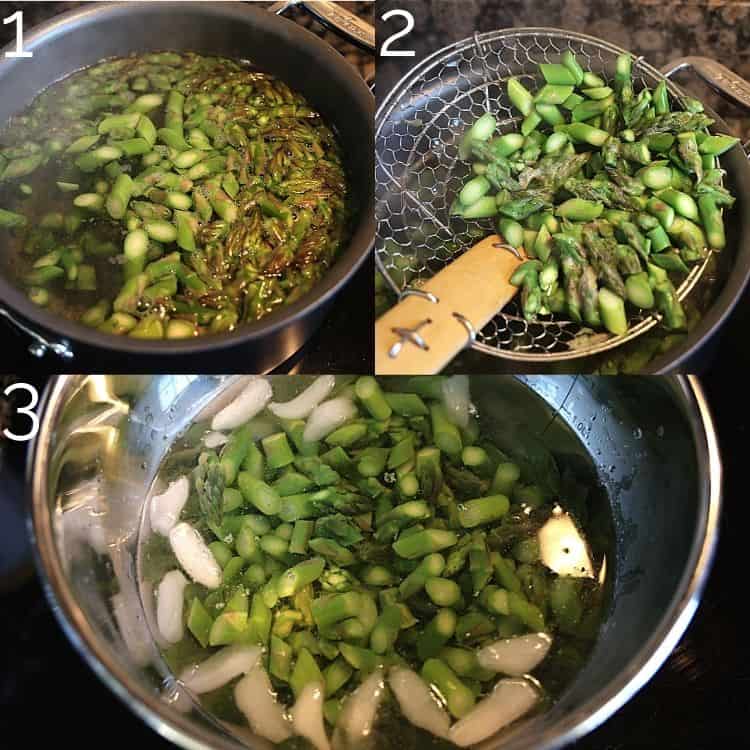
Not familiar? Blanching is a cooking technique that involves boiling your veggies and rapidly transferring them to an ice bath afterward so as to halt their preparation process.
Here’s how to blanch these spring veggies:
- Start off by blanching the vegetables in boiling water.
- The asparagus and peas will blanch for 2 minutes in the boiling water. This will cook them to a tender al dente consistency. Since the pieces are small, I recommend using a spider or mesh strainer to remove the vegetables.
- Immediately transfer them to a bowl of ice water to stop the cooking process. This will ensure you have perfectly cooked asparagus and peas so they do not become mushy when added to the risotto.
- Set aside till it’s time to use them.
Tip:
If you’re using frozen peas, skip this step!
Make the rice risotto
Now that you have all of your veggies prepped, it’s time to make the spring risotto, starting out with the base.
What’s the best rice to use for risotto?
Arborio rice is the best option as it’s a short-grain, high-starch variety that absorbs liquid better and cooks faster.
To make the risotto base:
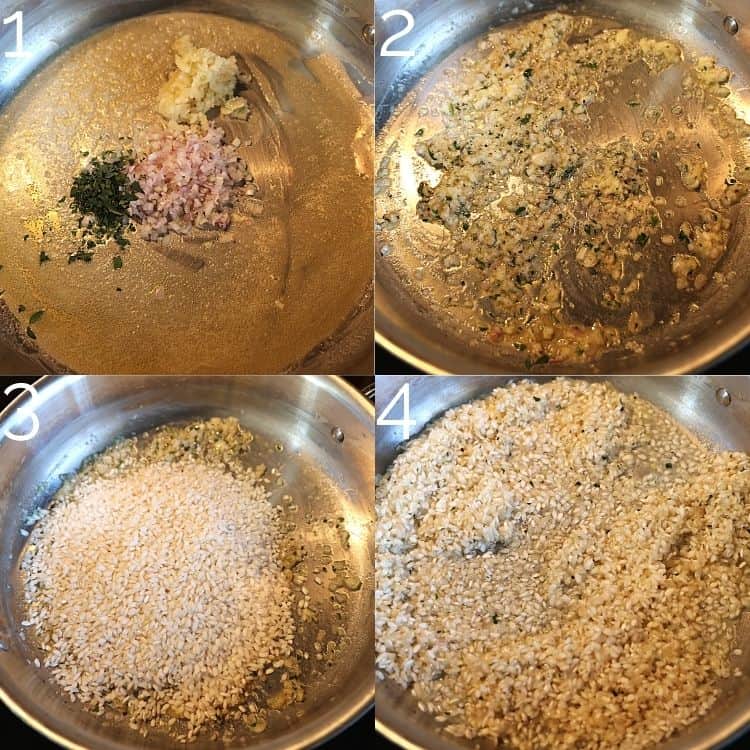
- Sauté butter, shallots, garlic, and fresh tarragon for 2-3 minutes, until the shallots begin to soften.
- Add in the arborio rice and toast for 2 minutes.
- Then, pour in the dry white wine and allow it to reduce by half.
Cook the risotto:
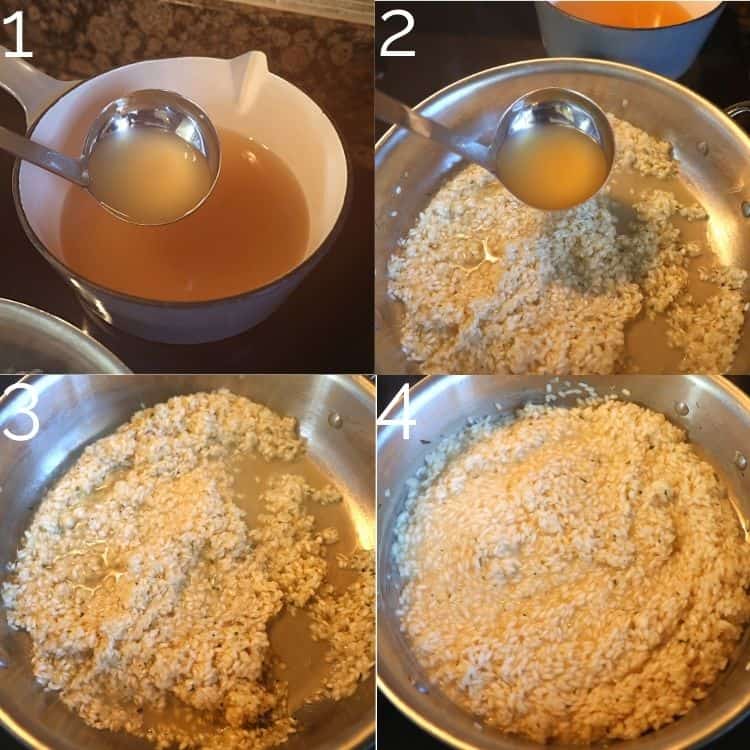
- While the wine in the rice is reducing, warm the broth in a saucepan over low heat.
Tip:
I use chicken broth for a more hearty risotto flavor, but you can use vegetable broth as well if you want the risotto to be entirely vegetarian.
- Gradually add 1 ladle of broth at a time to the risotto.
- Continuously stir the rice until the liquid is absorbed.
Tip:
Do not add another ladle until the liquid is fully absorbed by the rice. You will continue to do this until the risotto is fully cooked through, about 4 cups of broth.
Add in spring vegetables
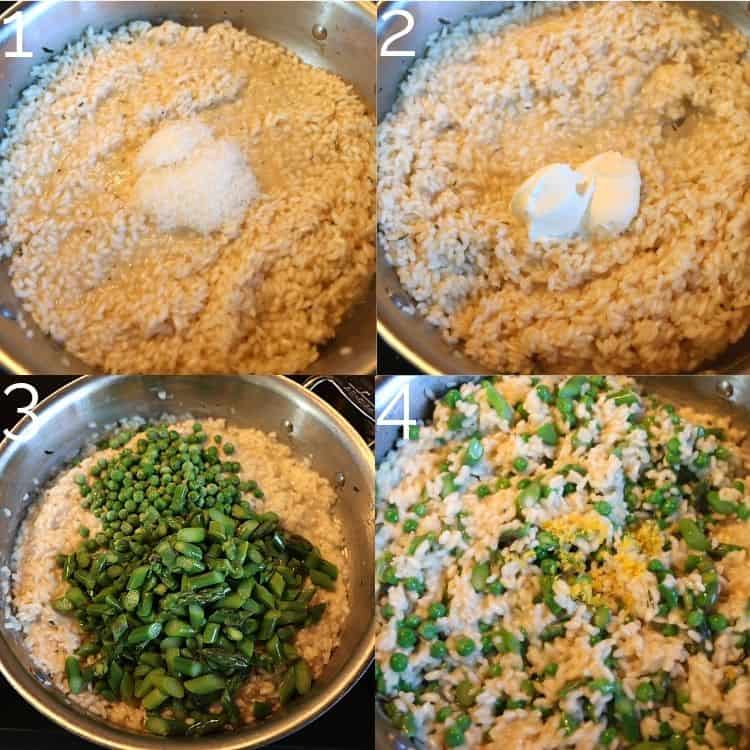
- Once the risotto is done absorbing the broth, add in freshly grated parmesan cheese and stir to combine.
- Then, add in the crème fraîche. This makes the risotto extra creamy and gives it a velvety texture!
- Add in the blanched asparagus and peas, followed by the lemon zest. The lemon brightens up the risotto, and the acidity cuts through the richness of the creamy base.
Season and enjoy!
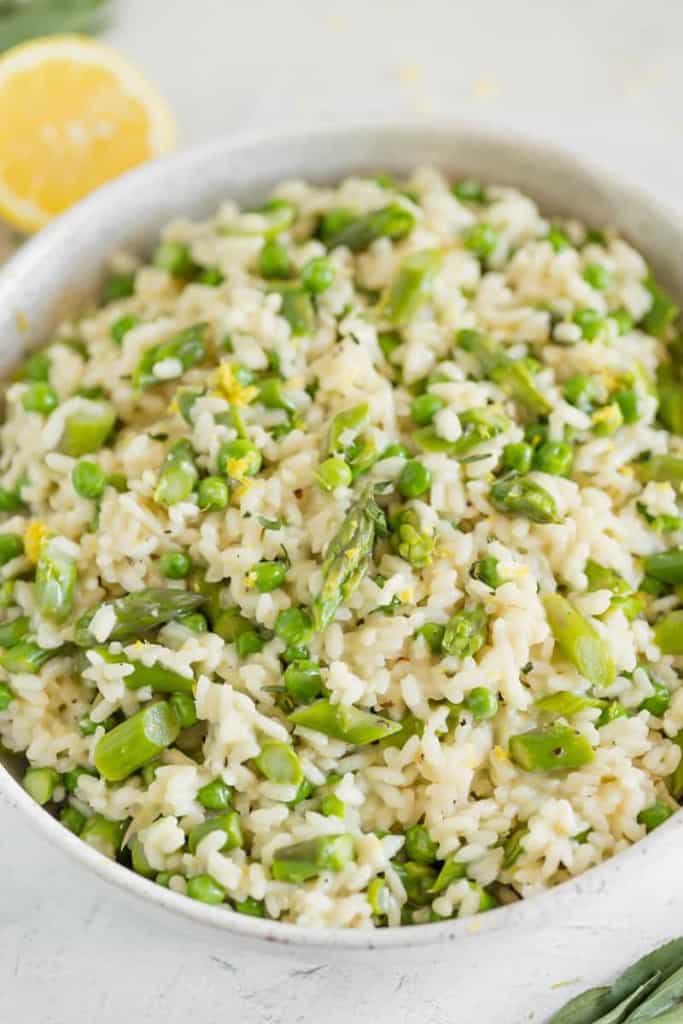
Once you’ve added all the ingredients, it’s time to take a taste and adjust your kosher salt accordingly. As the cheese is already salty, I suggest waiting until the end to add more if necessary.
Top it with a little bit more lemon zest (and maybe a squeeze of lemon juice), and enjoy!
How to serve
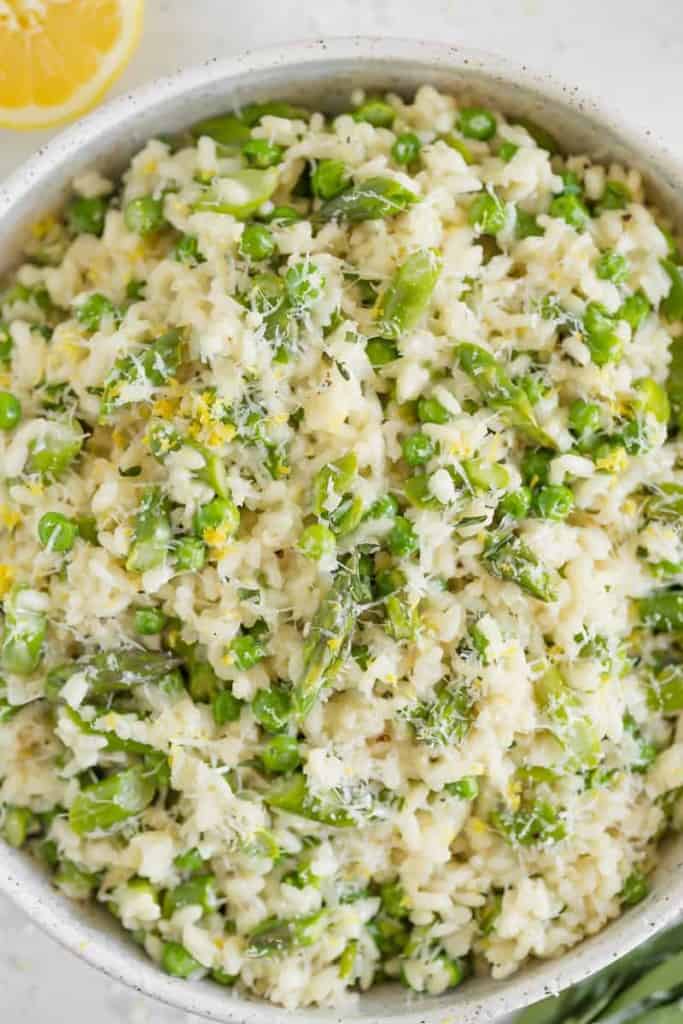
This spring asparagus & peas risotto is best served warm. You can serve it as-is, or try topping it with some fresh herbs like chives and basil for an extra springy flavor. If you want it to be extra cheesy, serve it with extra fresh parmesan over the top.
It’s also a great way to use up any leftovers the next day – just reheat and enjoy!
If you want to enjoy this healthy spring risotto with some extra protein, consider making some pan-seared tarragon chicken or some herb-grilled shrimp and chorizo.
Tip:
Love risotto? Try my mushroom sage risotto recipe!
How to store
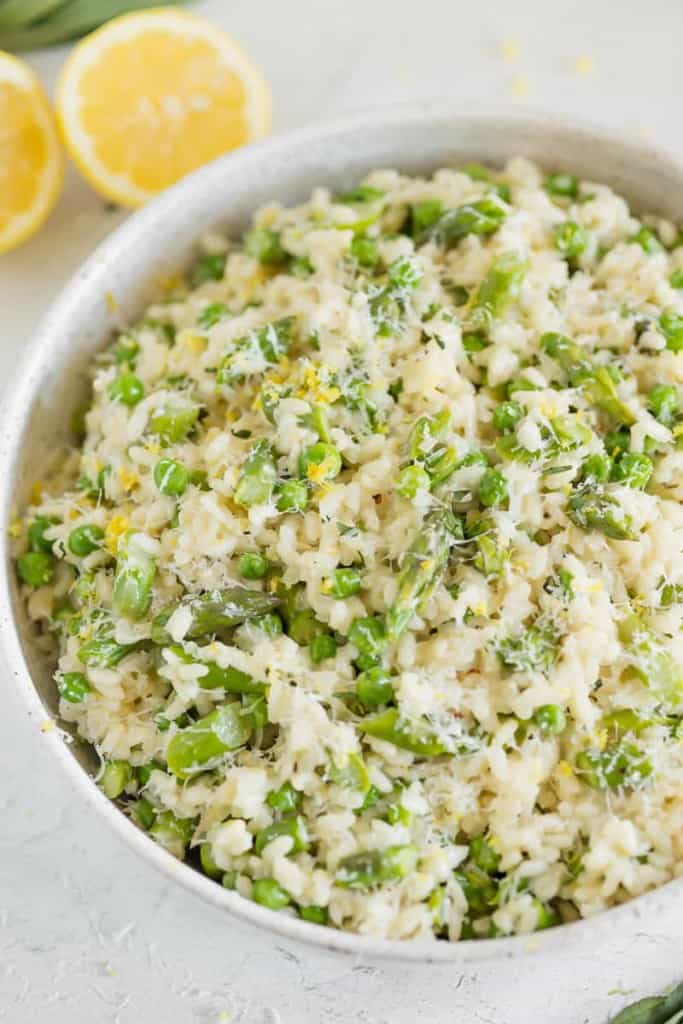
Once this easy pea and asparagus risotto is prepared, it can be stored in an air-tight container in the refrigerator for up to 3 days. Reheat in a saucepan on low heat when ready to enjoy again!
Love spring recipes? Try out these:
- Greek Orzo Pasta Salad
- Fiddlehead Ramp Cheese Tart
- Creamy Pesto Pasta
- Kale Caesar Salad With Chickpeas
- Marinated Steak Skewers With Chimichurri
For the web story version of this recipe, click here!
Made this recipe and loved it? Leave a star rating below!
Did you make this? If you snap a photo, please be sure tag me on Instagram at @girlwiththeironcast or hashtag #girlwiththeironcast so I can see your creations!

Spring Risotto with Asparagus and Peas
Ingredients
- 1 pound asparagus (ends trimmed, cut into 1/4 inch diagonals)
- 1 cup fresh or frozen peas ((see note))
- 2 tablespoons unsalted butter
- 2 tablespoons shallot (minced)
- 3 cloves garlic (minced or pressed)
- 1 teaspoon fresh tarragon (chopped)
- 1 1/2 cups arborio rice
- 1/2 cup dry white wine
- 4 cups chicken or vegetable broth (warmed in side pot)
- 1/4 cup crème fraîche
- 1/4 cup freshly grated parmesan (plus more for serving)
- 1 teaspoon lemon zest
- Kosher salt
- Freshly ground black pepper
Email this Recipe!
Email this recipe to yourself to save for later.
By submitting this form, you agree to receive emails from Girl with the Iron Cast.
Equipment
Before You Begin! If you make this, please leave a review and rating letting us know how you liked this recipe! This helps our business thrive & continue providing free recipes.
Instructions
- Bring a medium size pot of water to a boil. While the water is coming to a boil, fill a medium size bowl with 1 1/2 cups of ice and fill halfway with cold water, set aside. Once the water has come to a boil, add in the chopped asparagus and fresh peas (if using frozen peas, do not add to the boiling water). Boil for 2 minutes, then using a spider or mesh strainer, immediately transfer to the ice bath. Set aside.
- In a high walled skillet over medium heat, add the butter. Once melted and bubbling, add in the shallots, garlic, fresh tarragon, a pinch of kosher salt, and fresh ground black pepper. Sauté for 2-3 minutes until shallots begin to soften. Add in the arborio rice and toast for 2 minutes, by moving it around the skillet. Add in the white wine and allow to reduce by half, about 3 minutes.
- Slowly begin adding the broth one ladle at a time, continuously stirring. Do not add another ladle until the liquid has absorbed into the rice. Continue doing this until risotto is al dente and no longer absorbs liquid, about 16-18 minutes. Should be about 3 ½-4 cups of broth. You do not want it to be watery, risotto should be al dente.
- Once the risotto is done absorbing the broth, add in freshly grated parmesan cheese, the crème fraîche and stir to combine. Add in the blanched asparagus, peas, and the lemon zest. Stir until fully incorporated in the risotto. Taste and adjust the seasoning if necessary.
- Risotto is best served fresh and right away. I like to serve with extra fresh parmesan over the top.
Notes
Asparagus
- When picking asparagus you want to select firm and straight stalks, with the tips closed and compact. Trim the ends of the asparagus off, these are hard and unpleasant tasting. You can snap the ends off with your hands, the asparagus will snap at the natural point where the toughness begins.
Peas
- You can use fresh or frozen peas in this recipe. If using frozen peas, you do not have to blanch them with the asparagus.
Risotto
- When making risotto you want to use a short-grain rice, I prefer to use arborio. Due to it’s starchy nature, it absorbs less liquid giving you the perfect consistency for risotto.
- Ensure broth is warmed before adding it to the risotto
- Add 1 ladle at a time, continuously stirring until liquid is absorbed then repeat.
- Risotto should be al dente when done cooking, not mushy.
- Continuously stirring allows the rice to cook evenly, keeps it from burning, and gives the risotto that creamy velvety texture.
